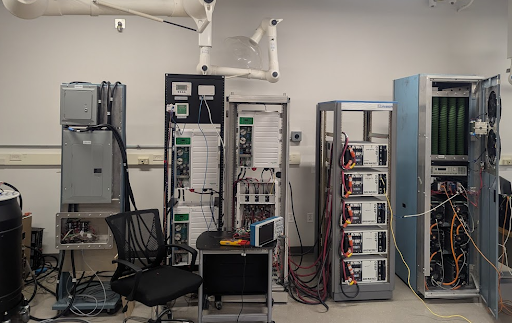Facilities
The Center for Integrated Electric Energy Systems utilizes various facilities at Stony Brook University, the SBU Advanced Energy Research and Technology Center (AERTC), and Brookhaven National Laboratory for the development of our research projects.
CIEES is currently designing and building out critical test bed infrastructure to help drive technology innovation in the grid integration space. These facilities include existing and operational microgrid and high voltage labs as well as several projects in the design and implementation phase, including a 13KV interconnect to a local substation, a HVDC interoperability studio, a renewable powered hydrogen testing facility, and several more.
The Exploratory Microgrid (Funded by the Office of Naval Research)

The microgrid setup is designed to accept a wide range of distributed generation and electric loads while maintaining the power quality as per IEEE StdF 519-1981. The Li-ion energy storage is realized by an array of BRENERGYTM4850 batteries (Brentronics, Commack, NY), pictured in the figure. The battery produces nominally 50.4VDC at a capacity of 100Ah. The battery supports high power discharge rates up to 250A (2.5C rate) for applications that need high peak power such as electrical motors, generators and equipment that have non-level load requirements while also providing storage/ buffering for stationary and portable on/off grid hybrid energy systems. Battery information such as State of Charge (SOC), battery voltage, battery current, battery temperature, cell temperature is monitored through a communication port.
The high power energy source is realized by supercapacitors manufactured by IOXUS Inc (Oneonta, NY). The supercapacitor bank is electronically switched to deliver instantaneous power when their dispatch algorithm decides that it is more beneficial to use the supercapacitor as a short term energy storage, rather than Li-ion battery source.
The system relies on the latest advances in low-latency communication. Unlike conventional droop controllers, which feature one degree of freedom (DOF) controller, the controller delivers a two-layer DOF adaptive control with a look-ahead load dispatch capability. Subsequently, the dynamic performance of the power sharing mechanism can be adjusted, without affecting the static droop gain, to damp the oscillatory modes of the power sharing controller. The load sends a power dispatch request directly to the inverter using the latest latency table, collected by the control station. The inverter controller pre-emptively adjusts its response based on the expected load profile.
The system is currently used to demonstrate and evaluate performance of grid sensors, energy storage, both commercial and residential, and to study the grid control algorithms.
